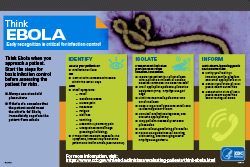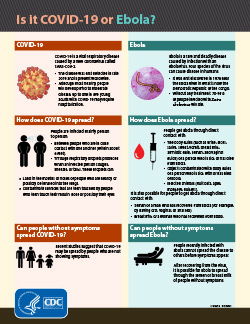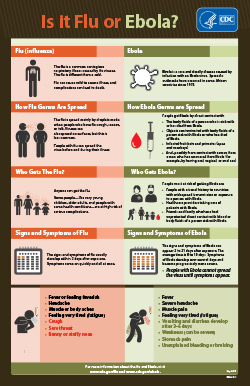Ebola Virus Disease
Ebola is also known as Ebola Virus Disease (EVD) or Ebola Hemorrhagic Fever (EHF). There are six Ebola subspecies, four of which are known to cause the disease. Ebola viral disease is a severe, often fatal disease that affects humans and some animals (like monkeys, gorillas, and chimpanzees).
What's New?
As of January 11, 2023, the Ebola outbreak in Uganda ended. For information on past outbreaks, visit the Centers for Disease Prevention and Control (CDC).
Healthcare providers should visit our For Healthcare Providers page for our consultation form and resources.
CDC Quicklinks
Brief History of EVD
Ebola virus was first described in 1976 near the Ebola River in what is now the Democratic Republic of the Congo. Since then, the virus has emerged periodically and infected people in several African countries. For more on the history of outbreaks, visit CDC's Outbreak History.
Information for Healthcare Providers
Ebola Virus Disease (EVD) is a rare and deadly disease in people and nonhuman primates. The viruses that cause EVD are located mainly in sub-Saharan Africa. People can get EVD through direct contact with an infected animal (bat or nonhuman primate) or a sick or dead person infected with the Ebola virus.
Identify, Isolate, Inform
Ebola Virus Disease (EVD) must be reported IMMEDIATELY to the Alabama Department of Public Health (ADPH).
- Identify - Look for epidemiologic risk factors in all travelers returning from areas with an active Ebola virus outbreak with signs and symptoms of EVD.
- Isolate - Begin immediate infection control measures for acutely ill patients with a concerning travel history.
- Inform - Notify your facility’s infection control program and other appropriate staff. Complete the ADPH Serious Infectious Disease (SID) Consultation Form and call the Infectious Diseases & Outbreaks Division immediately at 1-800-338-8374.
2022 Outbreak
- Ebola Outbreak Over in Uganda (January 11, 2023)
- HAN: Ebola Virus Disease (Sudan ebolavirus) Outbreak Information for Alabama Healthcare Professionals (November 10, 2022)
- HAN: Outbreak of Ebola Virus Disease (EVD) in Central Uganda - Be Prepared to Identify, Isolate, and Inform (November 3, 2022)
- COCA Webinar - Update on 2022 Ebola Outbreak in Uganda (October 12, 2022)
Resources
- CDC Travel Health Notices
- Think Ebola: Early Recognition
- Clinical Screening and Diagnosis
- DASH PPE Instructions
- Guidance for Donning and Doffing PPE
- Guidance on Performing Routine Diagnostic Testing for Patients with Suspected VHFs or Other High-Consequence Disease
- VHF Clinical Specimen Packaging and Shipping
- Infection Prevention and Control Recommendations for Patients in U.S. Hospitals who are Suspected or Confirmed to have Selected Viral Hemorrhagic Fevers (VHF)
- The Centers for Disease Control and Prevention has partnered with the National Ebola Training Education Center (NETEC). This site provides educational PowerPoint presentations, exercise templates, and general information about Ebola, MERS, and other infectious diseases.
- Access archived educational resources from the Emory University School of Medicine Serious Communicable Diseases Program
Page last updated: October 8, 2024







